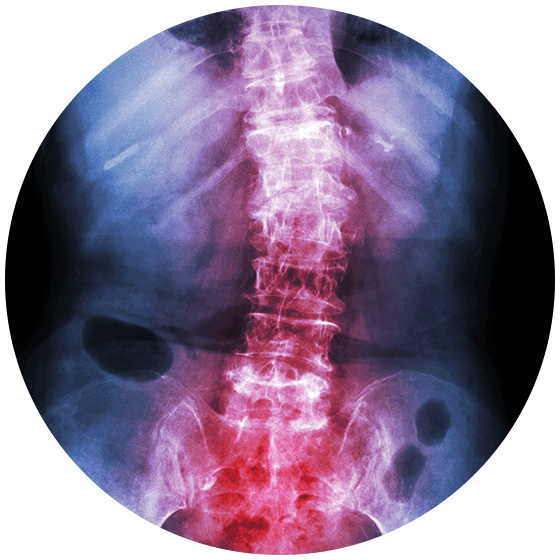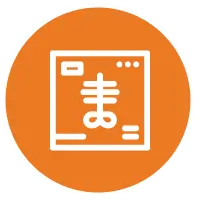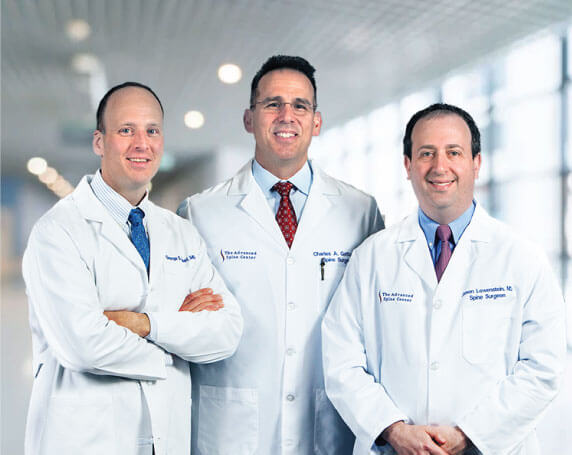Scoliosis Treatment in New Jersey & New York
Get expert care for pediatric and adult scoliosis from board-certified spine specialists. We offer advanced diagnostics, non-surgical therapies, and minimally invasive surgical options tailored to your needs.

What is Scoliosis?
Scoliosis is a form of spinal deformity that develops when the spine arcs in an abnormal, side-to-side curvature. A healthy spine should grow in a specific direction with a gentle forward and backward curvature. This design supports the weight of the body and our movements. When viewed from the front, your spine should form a straight line from the base of the skull to your tailbone. When viewed from the side, a healthy spine will adhere to a gentle curve. This arc bends backward at the neck and shoulders, before curving gently forward at the low back. If this typical shape is flawed or develops abnormally, a condition called scoliosis can occur.
Unfortunately, scoliosis is a progressive condition that worsens over time. Unlike many other spinal conditions, moderate to severe scoliosis can be distinguished through visual inspection. If you are suffering from this condition, your spine will adopt an abnormal S or C-shaped curve from side to side. This abnormal arcing may involve one or more rotations. Unfortunately, the causes of this spinal abnormality are diverse, and often, unknown. The key to a successful treatment is early and frequent intervention. If you or someone you know is noticing a change in the shape of their spine, don’t wait to seek help.
Pediatric Scoliosis
Pediatric Scoliosis can appear at any age during childhood, adolescence, or the teenage years. Using ultrasound technology, your doctor can even detect spinal deformities in a developing fetus! Most typically, however, individuals notice abnormalities during the teenage years, as visible changes in the spine appear. Because the adolescent years are crucial to spine development, untreated pediatric scoliosis can follow an individual into adulthood.
Adult Scoliosis
Adult Scoliosis typically results from a separate set of causes than pediatric scoliosis. Although the condition can develop in adolescence and follow an individual into adulthood, adult-onset scoliosis is usually caused by spinal degeneration. This breakdown is often associated with the aging process. Degenerative disc disease, damaged discs, spinal stenosis, spondylolisthesis, and arthritis can all lead to spinal damage—and adult scoliosis.
Scoliosis Treatment Options
The Advanced Spine Center, with locations in New York and New Jersey, offers comprehensive scoliosis pain treatment options, from conservative management to advanced surgical techniques. Treatment selection depends on factors such as curve severity, patient age, and individual circumstances.
This method of correction involves affixing screws to the vertebrae. These screws are attached on the convex side of the curve and fuse with the vertebrae over time. Once in place, a taut but flexible cord attaches to the screws to aid in the straightening process.
The use of external braces to treat scoliosis has been practiced for many years now. New advances in this technology have made braces more comfortable and less bulky. Depending on your situation, your physician may prescribe a hard, rigid brace or a soft, flexible one.
An osteotomy is a procedure that is used to restructure the shape of the spine through bone removal. Bone is removed in order to allow the vertebrae to fit together in a more functional manner. Hardware such as screws and rods may be needed to provide long-term stability.
Physical Therapy
Physical therapy is a widely successful and prescribed form of scoliosis treatment. It aids in improving strength and flexibility, regaining movement, and encouraging independence. Your physician will refer you to a physical therapist if needed.
Scoliosis Symptoms and Signs
Recognizing scoliosis symptoms early can significantly improve treatment outcomes and prevent the condition from progressing to a point where more invasive treatments become necessary. Many people mistakenly believe that scoliosis only causes back pain, but the reality is that this spinal condition manifests through a wide range of physical and functional changes that can affect multiple aspects of daily life.
The most obvious signs of scoliosis are typically visual asymmetries that become apparent when examining posture and body alignment. These changes often develop gradually, which is why they may go unnoticed by patients and family members until the curve becomes more pronounced. School screening programs and routine pediatric examinations play a crucial role in early detection, but parents and individuals should also be aware of the warning signs that warrant professional evaluation, including:
- Uneven shoulders or shoulder blades
- Prominent ribs on one side
- Uneven waist or hips
- Visible spine curvature
- Changes in posture or gait
- Back pain or stiffness
- Muscle fatigue
- Breathing difficulties (severe cases)
- Reduced mobility
If you notice any of these scoliosis symptoms in yourself or a loved one, it’s important to consult with a qualified scoliosis doctor near you as soon as possible. Early intervention can prevent progression, reduce the need for more invasive treatments, and improve long-term outcomes. At our New Jersey & New York spine centers, we provide comprehensive evaluations that include detailed imaging studies, functional assessments, and discussions about treatment options tailored to your specific needs and lifestyle goals.
What Our Patients Are Saying
Our experience with Dr. Lowenstein was fantastic!! When we found out our daughter would need surgery for her scoliosis. Of course we were all scared and nervous with the news. Dr. Lowenstein talked to us about everything, procedures, and concerns. He was absolutely fantastic!!
-Kerry H. ⭐️⭐️⭐️⭐️⭐️
Dr. Lowenstein and team are true professionals. Extremely well versed in overall spine care knowledge. Great experience, never rushed during office visits. He was trained by the best team of doctors at Columbia Presbyterian Scoliosis and Spine in NY of whom I had personal surgery from 25 years ago. I highly recommend this team. You will not be disappointed with their overall care, compassion and direction for your needs.
-Anthony F. ⭐️⭐️⭐️⭐️⭐️
Dr. Jason Lowenstein at The Advanced Spine Center is the BEST in his field and is also a very caring doctor. He totally straightened me from having scoliosis and I am able to walk without pain. I have already recommended him to a friend and will continue to do so, as there is no reason to go to any other spine surgeon then Dr. Lowenstein.
Geralyn C. ⭐️⭐️⭐️⭐️⭐️
Minimally Invasive Surgery for Scoliosis Pain
When scoliosis surgery is necessary, our local scoliosis experts specialize in minimally invasive techniques that offer significant advantages over traditional open surgery. Our advanced scoliosis surgery approaches provide:
- Smaller Incisions – Reduced scarring and better cosmetic outcomes
- Faster Recovery – Shorter hospital stays and quicker return to activities
- Less Pain – Reduced post-operative discomfort and medication needs
- Better Outcomes – Excellent curve correction with preserved mobility
With a team of fellowship-trained spine surgeons with extensive experience in both adult scoliosis treatment and pediatric scoliosis correction, The Advanced Spine Center has helped countless patients regain their quality of life.
Why Choose Us for Advanced Spine Care
The Advanced Spine Center in New Jersey is recognized as a leading destination for spine treatment in the nation. Patients choose us for their spine treatment because we offer:

Comprehensive Care
From initial evaluation to post-surgical care, we provide complete spine care. Our multidisciplinary team ensures optimal outcomes for every patient.

Advanced Technology
State-of-the-art imaging, surgical navigation systems, and minimally invasive instruments enable precise, safe spine care with excellent results.

Convenient Location
Easily accessible in New Jersey and New York , our modern facility provides comfortable care in a convenient location. Plus, patients from across the nation, and even world wide, find come to us!
Frequently Asked Questions About Scoliosis Pain
You should consider scoliosis treatment if you experience visible spine curvature, uneven shoulders or hips, back pain, or breathing difficulties. A thorough evaluation by a scoliosis specialist can determine if treatment is necessary based on your curve severity and symptoms and if that treatment plan should include a minimally invasive scoliosis surgery.
Untreated scoliosis can lead to curve progression, chronic pain, reduced mobility, breathing problems, and decreased quality of life. In severe cases, scoliosis can affect heart and lung function. Early treatment prevents these complications.
When scoliosis is severe or progressing rapidly, your physician may choose a more aggressive route. In these situations, an exaggerated spinal rotation can interfere greatly with one’s quality of life. Extreme curvature can impede movement and posture. If the extreme curvature of the spine strains muscles or pinches nerves, significant pain or reduced mobility can occur. Furthermore, severe curvature can even affect the function of your internal organs, distressing your heart and lungs.
Our team of spine experts at The Advanced Spine Center of New Jersey includes Dr. Jason Lowenstein, world-renowned scoliosis surgeon. Dr. Lowenstein is a fellowship-trained spine surgeon who specializes in the treatment of adult and pediatric spinal deformities. An expert in minimally invasive techniques, Dr. Lowenstein will develop a comprehensive treatment plan to correct your spinal curvature.
Ready to Take the Next Step in Your Spine Care?
Don’t let scoliosis limit your life. Contact the leading scoliosis specialists in NJ & NY today!
